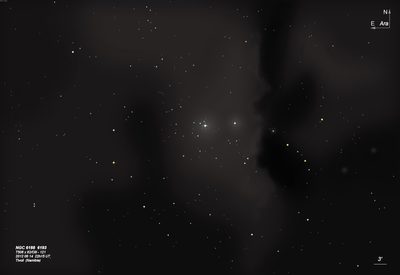Rim Nebula
Rim Nebula

John Herschel discovered NGC 6188 = h3640 on 15 Apr 1836 and recorded "The brightest part of a vL, faint, diffused, branching nebula, which involves in it nf part the star Brisbane 5789, and extends into the cluster D 413 [NGC 6193], which it in part surrounds. No doubt about the nebula, which in the brightest part of it precedes the cluster about 1 min of time. The following stars behind the double star, and quite free of nebula. I presume the neb and cluster to be unconnected." His rough position (nearest minute of RA and nearest minute of dec) was poor; it lands to the southwest of the nebulosity, about 22' SW of[NGC 6193, although he states the "brightest part of precedes the cluster about 1 min of time."
Despite many attempts, Joseph Turner (on 2 Jun 1877 and 16 Oct 1878) and Robert Ellery were unable to find this nebula with the Great Melbourne Telescope. This might be due to Herschel's poor position or the GMT's field of view was too small at the lowest power of 234x with a 14' field.
200/250mm - 8" (7/13/91 - Southern Baja): very large faint nebulosity which envelops open cluster NGC 6193, about 20' diameter. Extends roughly E-W through the cluster but also a very long brighter streak oriented N-S extends mainly to the south on the west side of cluster. This streak is well defined with an abrupt edge but there is no contrast gain with a UHC filter.
8" (7/16/82): faint, moderately large, low surface brightness glow on the west side of open cluster NGC 6193. This object is very low on the horizon from Northern California (less than 3 degrees max elevation).
400/500mm - 18" (7/10/02 - Magellan Observatory, Australia): With the 27mm Panoptic at 76x and UHC filter, this is an amazing region of bright and dark nebulosity involving open cluster NGC 6193 and extending throughout the entire 51' field in a N-S orientation. The bright nebulosity is split into two large sections by a dark lane that runs N-S. The eastern portion is the most prominent and includes the scattered cluster NGC 6193 and its three brighter stars (5.6/6.8/7). On the southern end of this section the nebulosity tapers down towards the SW corner, 15' to 20' from the core of the cluster. The western rim of the nebula is sharply defined with a locally brighter, crisp edge delineated by the dark river that meanders N-S throughout the field. The eastern and northern ends fade into the rich Milky Way background field.
A nearly perfect ellipse of moderately bright stars is just SW of the main body of the cluster and beyond the edge of nebulosity into the rift. The center of this ring is within the highest contrast portion of the dark rift, although the eastern side of the ring intersects the bright edge. This 15'x10' loop of stars spans the two sections of nebulosity.
The western portion of the nebulosity extends mostly NW of the elliptical ring and is clearly fainter. The highest contrast is along its eastern rim and runs N-S, roughly parallel to its brighter counterpart on the east side of the rift. The nebulosity fades towards the north and west with no well-defined edge but again is quite extensive. The catalogued dimensions of 20'x12' are too small and covers only the brightest portion of this much more extension HII/dark nebula complex.
Notes by Steve Gottlieb